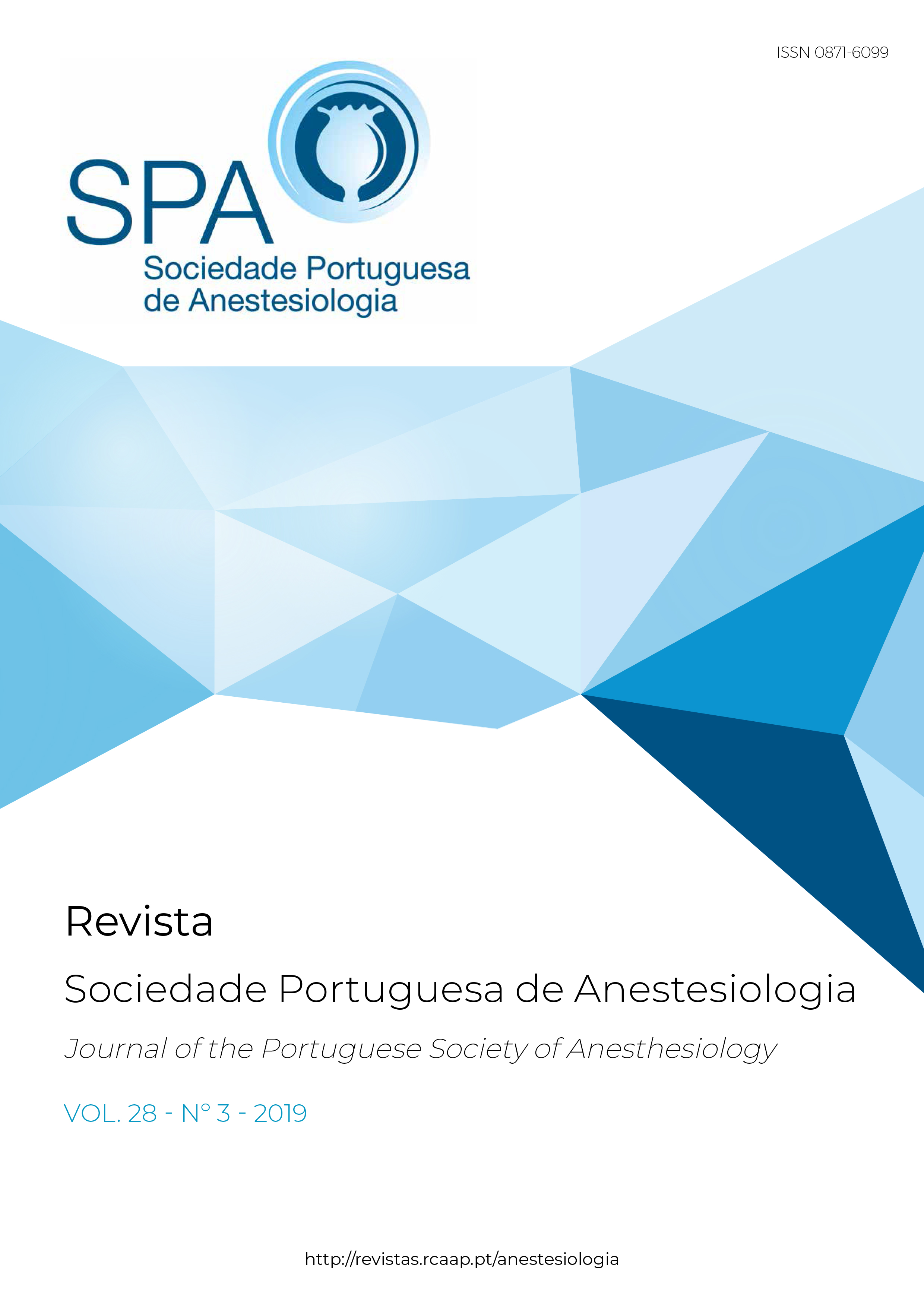Perioperative Predictors of Free Flap Damage in Head and Neck Surgery
A Retrospective Cohort Study
DOI:
https://doi.org/10.25751/rspa.17233Keywords:
Anesthesia; Body Mass Index; Free Tissue Flaps; Head and Neck Neoplasms/surgery; Postoperative Complications; Reconstructive Surgical Procedures/adverse effectsAbstract
Introduction: Microvascular free flap surgery improves survival and life quality. However, we lack knowledge on the best anesthesia approach. We aimed to identify predictors of flap damage.
Material and Methods: Eighty-seven patients submitted to head and neck free flap surgery were analyzed. The primary endpoint was flap damage (composite of complete flap loss, wound infection and 30-day re-intervention).
Results: Flap damage occurred in 18.6% patients (n=16). Body mass index was significantly different between groups. Patients with flap damage had a median body mass index of 20.56 [IQR 4.01] compared to 22.03 [IQR 5.02] in the control group. Body mass index had a significant discriminatory power for predicting flap damage (AUC 0.67 CI: 0.54-0.81). With a cut-off body mass index of 21, lower body mass index patients were at increased risk for flap damage (OR 3.96; CI: 1.24-12.69). They were more frequently mechanically ventilated >48 hours (56.3% vs 17.4%, p<0.05) or received postoperative blood transfusion (56.3% vs 20,3%, p <0.05). They had longer ICU (6.5 IQR 6 vs 4 IQR 4, p <0.05) and in-hospital stays (37.5 IQR 36 vs 18 IQR 17, p<0.05).
Discussion: Nutritional status should be a priority during patient selection. The association to mechanical ventilation, postoperative blood transfusion and prolonged in-intensive care unit stays reinforces
the need for optimal postoperative care.
Conclusion: Body mass index, mechanical ventilation, postoperative blood transfusion, longer intensive care unit and in-hospital stays were predictors of flap damage. Anesthesiologists should assume a coordinated perioperative medicine. Further studies are needed to clarify relevant practices.
Downloads
References
2. Leoncini E, Ricciardi W, Cadoni G, Arzani D, Petrelli L, Paludetti G, et al. Adult height and head and neck cancer: A pooled analysis within the INHANCE Consortium. Eur J Epidemiol. 2014;29:35-48. doi:
10.1007/s10654-013-9863-2.
3. Pereira CM, Figueiredo ME, Carvalho R, Catre D, Assunção JP. Anestesia e retalhos microvascularizados. Rev Bras Anestesiol. 2012;62:571-9.
4. Charters P, Ahmad I, Patel A, Russell S. Anaesthesia for head and neck surgery: United Kingdom National Multidisciplinary Guidelines. J Laryngol Otol. 2016;130(S2):S23-7. doi: 10.1017/S0022215116000384.
5. Kruse AL, Luebbers HT, Grätz KW, Obwegeser JA. Factors influencing survival of free-flap in reconstruction for cancer of the head and neck: a literature review. Microsurgery. 2010;30:242-8. doi: 10.1002/micr.20758.
6. Administração do Hospital Beatriz Ângelo. Relatório Anual sobre o Acesso a Cuidados de Saúde. Loures: HBA; 2014.
7. Remor CB, Bós AJ, Werlang MC. Características relacionadas ao perfil de fragilidade no idoso. Sci Med. 2011;21:107-12.
8. Haughey BH, Wilson E, Kluwe L, Piccirillo J, Fredrickson J, Sessions D, et al. Free flap reconstruction of the head and neck: Analysis of 241 cases. Otolaryngol - Head Neck Surg. 2001;125:10-7.
9. Üstün GG, Aksu AE, Uzun H, Bitik O. The systematic review and meta-analysis of free flap safety in the elderly patients. Microsurgery. 2017;37:442-50. doi: 10.1002/micr.30156.
10. Scott MJ, Baldini G, Fearon KCH, Feldheiser A, Feldman LS, Gan TJ, et al. Enhanced Recovery after Surgery (ERAS) for gastrointestinal surgery, part 1: Pathophysiological considerations. Acta Anaesthesiol Scand. 2015;59:1212-31. doi: 10.1111/aas.12601.
11. Khan MN, Russo J, Spivack J, Pool C, Likhterov I, Teng M, et al. Association of body mass index with infectious complications in free tissue transfer for head and neck reconstructive surgery. JAMA Otolaryngol Neck Surg. 2017;143:574-9. doi: 10.1001/jamaoto.2016.4304.
12. Naderi N, Kleine C, Park C, Hsiung JT, Soohoo M, Tantisattamo E, et al. Obesity paradox in advanced kidney disease: from bedside to the bench. Prog Cardiovasc Dis. 2018;6:168-81. doi: 10.1016/j.pcad.2018.07.001.
13. Fitness IR, Milani R V, Blair SN, Milani RV, Blair SN. Obesity and cardiovascular diseases and severity in the obesity paradox. J Am Coll Cardiol. 2014;63:1345-54. doi: 10.1016/j.jacc.2014.01.022.
14. Wang S, Ren J. Obesity paradox in aging: from prevalence to pathophysiology. Prog Cardiovasc Dis. 2018; 61:182-9. doi: 10.1016/j.pcad.2018.07.011.
15. Coyle MJ, Main B, Hughes C, Craven R, Alexander R, Porter G, et al. Enhanced recovery after surgery (ERAS) for head and neck oncology patients. Clin Otolaryngol. 2016;41:118-26. doi: 10.1111/coa.12482.
16. Mitchell CA, Goldman RA, Curry JM, Cognetti DM, Krein H, Heffelfinger R, et al. Morbidity and survival in elderly patients undergoing free flap reconstruction: a retrospective cohort study. Otolaryngol Neck Surg. 2017;157:42-7. doi: 10.1177/0194599817696301.
17. Ibrahim AM, Kim PS, Rabie AN, Lee BT, Lin SJ. Vasopressors and reconstructive flap perfusion: a review of the literature comparing the effects of various pharmacologic agents. Ann Plast Surg. 2014;73:245-8. doi: 10.1097/
SAP.0b013e31828d70b3.
18. Scholz A, Pugh S, Fardy M, Shafik M, Hall JE. The effect of dobutamine on blood flow of free tissue transfer flaps during head and neck reconstructive surgery. Anaesthesia. 2009;64:1089-93. doi: 10.1111/j.1365-2044.2009.06055.x.
19. Paiste J, Simmons JW, Vetter TR. Enhanced recovery after surgery in the setting of the perioperative surgical home. Int Anesthesiol Clin. 2017;55:135-47. doi: 10.1097/AIA.0000000000000160.
Downloads
Published
How to Cite
Issue
Section
License
Articles are freely available to be read, downloaded and shared from the time of publication.
The RSPA reserves the right to commercialize the article as an integral part of the journal (in the preparation of reprints, for example). The author should accompany the submission letter with a declaration of copyright transfer for commercial purposes.
Articles are published under the terms of the Creative Commons Attribution Non-Commercial License (CC BY-NC).
After publication in RSPA, authors are allowed to make their articles available in repositories of their home institutions, as long as they always mention where they were published.


